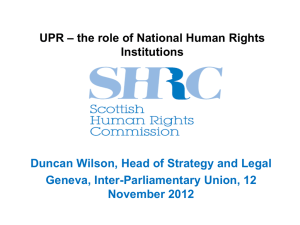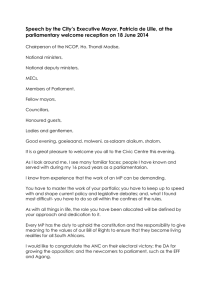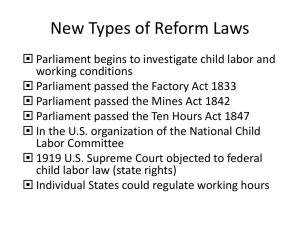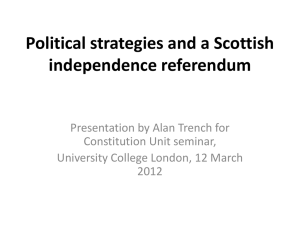evements of the Achi Scottish Parliament The Leverhulme Trust
advertisement
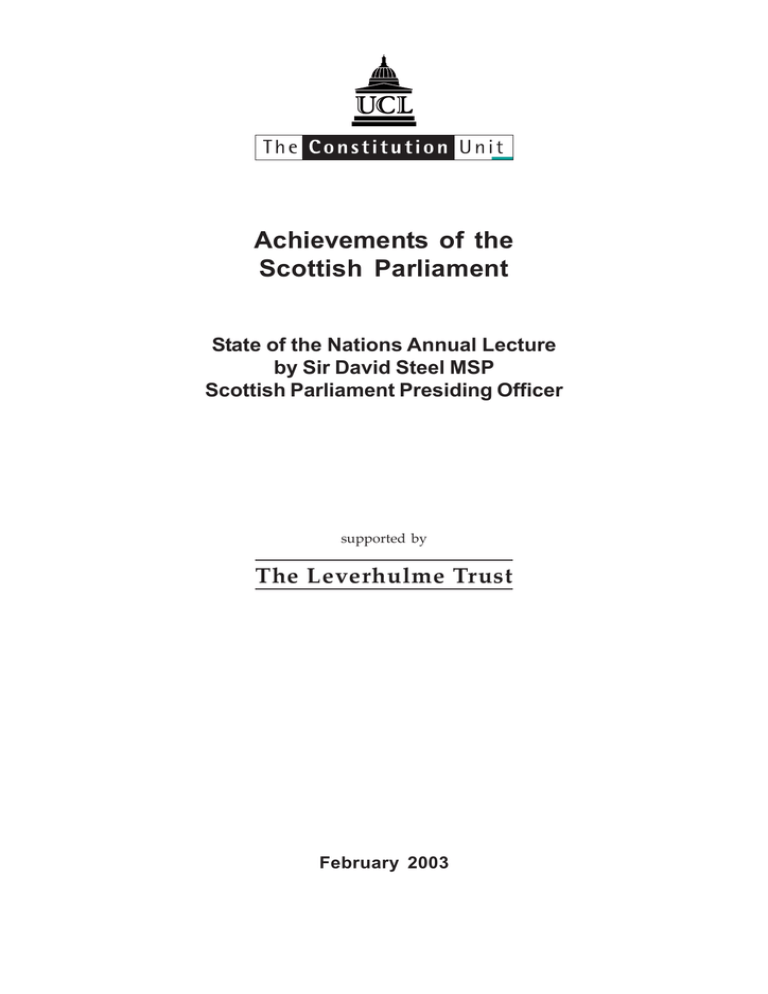
Achievements of the Scottish Parliament State of the Nations Annual Lecture by Sir David Steel MSP Scottish Parliament Presiding Officer supported by The Leverhulme Trust February 2003 ISBN: 1 903903 19 X Published by The Constitution Unit School of Public Policy UCL (University College London) 29–30 Tavistock Square London WC1H 9QU Tel: 020 7679 4977 Fax:020 7679 4978 Email: constitution@ucl.ac.uk Web: www.ucl.ac.uk/constitution-unit/ The Constitution Unit, UCL 2003 This report is sold subject to the condition that is shall not, by way of trade or otherwise, be lent, hired out or otherwise circulated without the publisher’s prior consent in any form of binding or cover other than that in which it is published and without a similar condition including this condition being imposed on the subsequent purchaser. First Published February 2003 Achievements of the Scottish Parliament The State of the Nations Annual Lecture Sir David Steel MSP, Scottish Parliament Presiding Officer 29 January 2003, City Chambers, Edinburgh May I begin by thanking you for inviting me to deliver The Constitution Unit’s annual lecture. Tonight I want to pick up three distinct themes in giving my views on the ‘the State of the Nation,’ addressing some of the points discussed in Robert Hazell’s book of the same name. First, I want to look at the impact of devolution in Scotland and examine exactly how far we have come in constitutional change. Second, I thought it might be interesting to take a closer look at the views and opinions of those outwith the Parliamentary campus. Do those people who come into direct contact with the feel that Parliament is as open and accessible as is claimed? And third, I want to offer some insights into how I see things might be improved in the years to come and some of the challenges that await. With the passing of the Scotland Act, the United Kingdom saw the single biggest constitutional change since the partition of Ireland in the early part of the 20th century. For Scotland, the birth of the new Parliament clearly represents the biggest constitutional change since the Act of Union. A monumental change. A seismic shift in the political landscape, but incredibly, one that we almost seem to take completely for granted these days. Against the perspective of three hundred years, it is hard to believe how far we have come in four short years. With the Parliament firmly established at the centre of Scottish political life, our transition to a new democracy has been both swift and smooth. I do not pretend that the early days of the Parliament’s existence have been without hiccup or stooshie, but it seems almost easy to overlook the magnitude of the shift in balance of power from Westminster to Scotland. Yet despite the apparent ease of transition, one cannot underestimate just how massive the constitutional change has been. On the night of the referendum result in 1997 and on the opening day of the Scottish Parliament on 1 May 1999 we celebrated the success of a decadeslong campaign won. Tonight it is worth reflecting upon the years that went before devolution, the constitutional arguments along the way and the experience of our first four years of the new Scottish Parliament. In the days of the Scottish Office, we saw from time to time Secretaries of State who didn’t always enjoy the luxury of an electoral mandate from the people they were there to serve, the people of Scotland. Accountability for the Secretary of State and his team of four or five Ministers usually entailed 60 minutes of Question Time in the House of Commons each month. The government’s legislative programme would perhaps see two or three Scottish Bills each year, sometimes even that would include a tartan version of an English and Welsh Bill that was being brought 3 forward. In those days on a Monday night ministers would take the shuttle to Heathrow, spend the week in Dover House and, depending on the vote, maybe get the shuttle back on Thursday evening if they were lucky, or more likely the sleeper if the Commons sat late. Appearance before a parliamentary committee might entail the odd turn before the Scottish Affairs select committee, or perhaps even an outing with the Scottish Grand Committee as it went on tour round Scotland with Michael Forsyth. By July 1997, with Donald Dewar in post as Secretary of State, he published his White Paper Scotland’s Parliament’; in September 1997, we voted “Yes, Yes” in a referendum and before the year was out the Scotland Bill was introduced in December 1997. From the White Paper to the passage of the Scotland Bill we heard arguments for and against the government’s programme for constitutional reform. We heard debates on lofty issues such as whether sovereignty could be divided or whether the UK parliament would remain sovereign. Long into the night we would discuss how any constitutional crisis or impasse between London and Edinburgh would need to be resolved by the Judicial Committee of the Privy Council which would sit in the event of any dispute between the Scottish Executive and the UK Government, were there ever to be disagreement over where vires lay. Some of you may think that yesterday, John Prescott made a fair attempt at throwing a spanner in the works. In reality, few of these constitutional issues seem to have much bearing on our day to day work in the Scottish Parliament, but that serves only to play down the monumental shift in the landscape. The creation of a Scottish executive, with Ministers meeting at cabinet in Edinburgh was clearly an important step forward from the days of the Scottish Office and the old style Secretary of State. But the constitutional giant leap as it were, comes from the creation of a Parliament which brings with it a whole new process and culture of lawmaking, accountability and representation. Incredibly, there have been over 1600 meetings of Scottish Parliamentary Committees since May 1999 and their work has been absolutely crucial to the success of the Parliament. They are an integral—not subsidiary—part of the parliamentary process. Indeed, I would argue that our convention of not allowing the committees to sit at the same time as the chamber enhances their role and authority. It is important to remember Committees do not just serve to consider the Executive’s legislative programme. In just four years, eight non-executive Bills have received Royal Assent in the Scottish Parliament with a further three possibly receiving Royal Assent before the end of this session. By contrast, in the four years immediately preceding devolution, Westminster passed only three ‘Scotland only’ Private Members Bills. Now this is a significant point. Non-executive legislation is a powerful means of sharing democratic power 4 amongst all Members and ultimately the people they represent. As an important constitutional development three of the eleven pieces of non-executive legislation have been Committee Bills. I have no doubt that we will see even more Committee Bills in the fullness of time. I am equally sure our Non-Executive Bills Unit, created only in the year 2001, will continue to be as busy. Already there is a substantial number of worked-up proposals waiting in the wings as a result of work carried out by MSPs in this session. Shared innovation in democratic practice, such as Committee led legislation, is one way of measuring the Parliament’s success. The effectiveness in which Committees are able to influence the Executive is another: The Local Government’s Non-domestic rates inquiry led to the Executive agreeing a relief scheme for small businesses. Many business leaders in Scotland of course, welcomed this. The Federation of Small Business commented ‘the Parliament is beginning to understand the issues that affect Scottish businesses’; the Justice One Committee’s unanimous report on the prison estates review was important in influencing the Executive’s decision not to close Peterhead prison; The Health and Community Care Committee recommended that personal care for the elderly should be free. The proposals made by the Enterprise and Lifelong Learning Committee in its SQA inquiry was another strong example of the Committee structure working well. The Committee recommendations being adopted almost wholesale by the Executive. The Local Government Finance inquiry—through which the Executive agreed with the proposal to abolish ‘section 94 consent’ to borrow, was hugely important to local authorities. One Council noted ‘Local government had sought this kind of inquiry for many years. The Scottish Executive and formally the Scottish Office, had indicated that it was unwilling to carry out this kind of review. Therefore without the existence of the Local Government Committee, this particular review would not have been undertaken. The Council welcomes the Committee’s role which demonstrated that the Scottish Parliament is being responsive to the views of local government and has taken the necessary action to address this issue’. Such comments are very encouraging—and there have been many similar views expressed. The success of any policy is measured by the success of delivery, and a collaborative approach with local authorities and other service providers is essential if devolution is to be successful. One measure the Parliament has taken in recognising the need for a collaborative approach has been to pass The Local Government in Scotland Bill, which has just completed its passage through the Parliament. 5 This important legislation gives councils new powers to engage public sector partners in community planning and provides a ‘power of community well being’ which will allow councils to take action which they consider will benefit their communities. And that brings me to another way of assessing the Parliament’s success—just how accessible the Parliament is to ordinary Scots and their communities. Committees clearly support the principle of shared power between the people of Scotland and the legislature, providing as they do the opportunity for the public to identify issues requiring attention and action by the Parliament. With Committees actively seeking views of people, there is obviously some duty on the Parliament to respond to these. In this way, Committee agendas become shared responsibility, resulting ultimately in shared power. In total, Committees have met nearly 50 times outwith Edinburgh. From the outset this was to be Scotland’s parliament—not Edinburgh’s, not a central belt Parliament but, a Parliament for all of Scotland. Parliamentary Committee reporters have undertaken more than 200 fact finding visits to every corner of Scotland. The fact that Committees have been willing and able to take evidence in different parts of the country has been extremely valued, not only by the Committees themselves, but by those giving evidence. Of course, the Parliament has also actively sought innovative ways to collect views and often this has involved staging events in the Parliament and inviting stakeholders to take part. As part of the Renewing Local Democracy inquiry, the Local Government Committee held major civic participation events in Paisley, Inverness and Glasgow. The Glasgow event was held at the weekend to allow working people to attend, and was also targeted at the sectors of the population under-represented in the previous two events. The event was also used to test possible inquiry conclusions. In 2000, the Enterprise and Lifelong Learning Committee invited over 100 businesses to an event called ‘Business in the Chamber’ where they were able to sit in the Chamber and debate the Committee’s Interim Report on Local Economic Development Services. As you know, only MPs may ever sit on the green benches in the Commons. There were three debates on different aspects of the report, at the end of which they got to vote on our proposals. The debates had an impact on their Final Report as the recommendations were changed to reflect business views, e.g. on the role of business advisers. In April 2002 the Committee held a Lifelong Learning Convention at the EICC drawing together over 200 ‘stakeholders’ in lifelong learning to discuss its Interim Report on Lifelong Learning, similar to Business in the Chamber model. They held 16 workshops on different aspects of the report, which also had a positive impact on the Final Report. The Convention was very well received by attendees. Interestingly, this not only gave the Committee the opportunity to hear views, but the session also acted as a platform for various interests to learn from each other. One participant commented, 6 “ the main value for me was not so much a feeling of being heard/consulted, but hearing the perspectives of a range of others—people I don’t normally have much chance to debate with.” And this perhaps sums up our inherent value. Fast track courts created to speed up the compensation process for asbestos victims; the formation of an MMR Expert Group; calls for risk assessment procedures in GM crops to be improved, an expert group on Hepatitis C. These are real issues; topical issues; and important issues for many people in Scotland. And yet, these measures and many others, came about not at the Executive’s or the Parliament’s initiative but through the people of Scotland and their communities who decided they would take action, and became involved in the democratic process. By using the Parliament’s Public Petitions Committee, ordinary Scots have helped shape the agenda of the Scottish Parliament. The Petition system unquestionably plays a key role in fulfilling the Scottish Parliament’s overall commitment to accessibility, public involvement and openness. Unlike Westminster where signatories of petitions are simply counted and put in a bag behind the Speaker’s chair, petitions that come to the Scottish Parliament—and there have been almost 600 to date—are all actioned in some way. In determining the appropriate action to be taken on a petition, account is taken of the strengths and depth of the support it enjoys and not simply the number of signatures the petition has. Residents in the small community of Blairingone complained through a petition that waste from abattoirs was being spread on land near their homes. One petitioner commented in an interview that MSPs “were actually sitting taking evidence from people in their own homes and that brought the Parliament much closer to the people than they’ve ever been before”. The Transport and Environment Committee who considered this petition, subsequently made recommendations for changes to the regulatory framework governing the spreading of waste— the Executive implemented the necessary changes. The Petitions Committee is taking steps to ensure that the petitions system is further developed and improved. For example, the Scottish Parliament leads the way in actively promoting the use of modern innovative petitioning techniques through its electronic petitions system, and this will come on-line shortly, following a successful two-year pilot. But it is not just the Public Petitions Committee that has proved how accessible the Scottish Parliament is. The operation of a number of committee investigations has enhanced Scottish democratic life by making the system more accessible. One leading children’s charity in Scotland commented, ‘Through individual MSPs and Committees we have felt there have been increasing opportunities for us, as a voluntary child care organisation, to make a contribution to debates on issues affecting children and young people. The Committees are to be applauded for carrying out the dual role of inquiry and the legislative scrutiny and for welcoming in representation’. 7 There is clear discernible evidence that people have chosen to give evidence to Committees. In fact, over 1900 individuals have done so since 2001 and this has served to enhance the ability of ordinary Scots to influence policy-formulation at the development stages. The Citizen’s advice Bureaux Service certainly feels it has a ‘greater connection to the policy-making process through the Parliament’. This in turn, they point out, ‘means better connection between the hundreds of thousands of issues that people in Scotland bring to the Bureaux each year, and those politicians elected who can make a difference’. Martin Sime, Chief Executive of the Scottish Council of Voluntary Organisations recognises this need: “It is a fair measure of [the Parliament’s] success that the voluntary sector cannot now imagine public affairs without a Scottish Parliament. Voluntary organisations must constitute the largest single group of lobbyists and are serial evidence givers to the committees. At least in part this has happened because they have been encouraged to do so. A symbiotic relationship has been built and a fair amount achieved in only four years” Of course, being accessible also means being open. Perhaps, one reason the Parliament receives so much criticism is because it is so open. This in itself should not be seen as a bad thing. It does mean, however, our Parliament is often seen warts and all, as it learns and grows. Unfortunately all this work by committees, and the cross party nature of much of it, goes sadly underreported in the media, because it is not as exciting as clashes in the chamber, the loss of two First Ministers, or stories about the new Holyrood building. Let me take a second to report on that front. When I was on site last week I was delighted to see the renovated Queensberry House emerge from behind its scaffolding on the south side, revealing the latest glimpse of the project as it nears completion. And next to Queensberry House we begin to see the intricate glass leaf shapes which will form the breath-taking roof, which spans Miralles’ spectacular central lobby at the heart of his design. I have already said a number of times on record that I agree with the First Minister: the costs of the new building are both unpopular and disappointing. It would have been entirely different if we had been erecting a conventional building with the standard components on a fixed price (as was presumably envisaged with the £40 million estimate in the 1997 Westminster Government White Paper) but decisions not just on the site and architect but on the contract management procedure and including the very expensive renovation of Queensberry House were all taken before the Scottish Parliament was created. All but one of the 64 trade contracts at Holyrood have been let. 29 trade contractors are currently on site, working alongside more than 40 sub-contractors. I can assure you that the members of the all-party Corporate Body which I chair have found it a deeply frustrating experience, but in five to ten years time, as with Sydney Opera House, the public will be proud of an internationally renowned 21st Century building in our capital city. 8 Returning to the openness of the Parliament, I don’t want to dazzle you with figures, but just to give you an idea of how we have tried to be open here is a sample. Our telephone Enquiry Line and Public Enquiry Office has received nearly 350,000 enquiries. Over 15,000 people have attended the Parliament’s Open Days; we have received over 22,000 visits by school pupils through the education services and that’s an important figure. I have no doubt that the work of our education services, which is linked to the school curriculum will result in greater civic awareness in years to come. The Electoral Commission recently pointed out that people in the 18—24 age groups were least likely to vote. And lastly our website—the modern age means to being open to modern ways. The Parliament’s website has been voted the third best of any Parliament in the world by a survey in an English newspaper. Well over 23 million hits have been recorded with many people finding the site easy to navigate and full of useful briefings and information. One obvious sign of our openness has been the high profile and very public issue of putting in place robust procedures to regulate Members’ conduct. In fact, the Parliament is to consider the appointment of a new Standards Commissioner this week—whose job it will be to ensure the highest standards of probity in public life. This openness in procedure and practices of Members does not happen to the same extent in other parliamentary institutions and has been noted as far stricter than the rules at Westminster. As the pace of change quickens in developing confident links with more and more areas of Scotland, we will continue to be open; continue to recognise the valuable contribution of all sectors and all individuals. There should be no apology for this; being an open institution is vital to a healthy parliamentary democracy and essential in supporting the most excluded, vulnerable and disadvantaged in society. Scotland is a diverse country. A country that is made up of many cultures and influences. This all serves to enrich our country but it is vital that our society is underpinned by equality. The Equal Opportunities Committee serves to ensure fair democratic representation, going to considerable lengths to invite input from the broadest range of interests and ensuring that individuals giving input are treated with respect. The Commission for Racial Equality has given evidence on a number of occasions and has made a number of interventions on proposed legislation. They commented some time ago that ‘Those inequalities groups and communities of interest which have been affected by the Equal Opportunities Committee feel a strong sense of inclusion…’. While we are very proud that 37% of our Members are women, it is true that we do not have any Members registered as disabled, nor do we have any Members from ethnic minorities. This is certainly something I would like to see rectified in future Parliaments. As I said at the beginning, it remains for others to decide whether the Parliament has been successful. 9 I hope people will see how far we have come. No question it has been a busy and demanding time. But equally a rewarding time. 45 Bills have received Royal Assent, nearly 2000 pieces of secondary legislation has been passed, nearly 33,000 parliamentary questions have been lodged, and there have been over 1000 electronic votes in the chamber. On these figures it would be hard for people to shout ‘what are we paying these MSPs for’. Although we recognise lessons have been learned along the way. Given the size of the undertaking and the amount of work completed, this is only to be expected. The important point is that we are learning quickly and moving forward. The practices and procedures of the Scottish Parliament are flexible and, where necessary, could be adapted with relative ease. There will be inevitable adjustments to working practices with the evolutionary process. Helen Liddell’s ‘129 MSPs’ announcement means that the Scotland Act will be revisited by Westminster sometime after the next UK Parliamentary election due by 2007. This will offer us the opportunity to examine other areas where our establishing legislation can be improved: Sometime around 2007, not in the life of the next Scottish Parliament but the one after, there will to be a review of the Scotland Act. By then, with ten years’ experience of parliamentary life under our belt this will give us an ideal opportunity to take stock of how our institution functions and of any refinements that are required. After all, as Donald Dewar pointed out, devolution is a process not an event. No doubt the funding question will arise at around the same time in view of the commitment to review the Barnett formula. I do not propose to touch on the economic question today. However, we have already identified a number of what I call “housekeeping” matters which by now most of us are agreed should have been transferred to the Scottish Parliament and which no doubt will be in future. For example the question arose of our inability during my illness even to appoint a temporary extra Deputy Presiding Officer without asking Westminster to amend the Act. In my opinion, one of the issues which should be examined after a decade of experience is our process of legislation. Given that we are unicameral does our pre-legislative scrutiny by committee act as a satisfactory “revision” process? I believe that on the whole it does, but a respected journalist has queried whether this is always the case and argued, that in examination of the Land Reform Bill undue prejudice was shown by Committee members against some witnesses whilst one organisation was denied a hearing at all. I do not wish to comment on these allegations especially since he was not actually present, but they do raise the old question of whether a further revision method might usefully be introduced. I must emphasise that my thinking has been somewhat misinterpreted and misunderstood following a newspaper interview where I raised this question. I am emphatically not proposing a Scottish House of Lords, nor a “second Chamber” of any 10 kind. Another commentator even suggested I was proposing a body for my own personal continuation, ignoring the fact that I was discussing a post-2007 review, while a Daily Mail editorial had me building a second Chamber in addition to the expense of Holyrood! Let me elaborate. We already have a limited revision mechanism. Every Act once passed by the Scottish Parliament is considered for a period of a month by the Law Officers in Scotland and Westminster to see whether in the course of its passage and amendment it might breach either the Scotland Act or the European Convention on Human Rights. If so, they can send it back for adjustment. It has never happened yet. Only after I have heard they have no objection do I write to the Queen requesting her Royal Assent. What could be considered—and again I stress that the case is too early to be judged—is an external review panel, appointed by Parliament on all-party nominations, who could simultaneously look at the wider implications of the legislation, hear any grievances, consider any flaws in the legislative process and have the same capacity to refer an Act back for further consideration. Any such review panel should be small, reflect civic Scotland and avoid too many party politicians. It could meet in our Committee rooms and involve very little public expense. It is not an idea which should be rubbished on wild comparisons with Westminster’s upper Chamber. One feature of the Parliament which has developed over these first four years is what I would call the esprit de corps. Many of our staff were recruited from the old Scottish Office, some from Local Government and surprisingly only two from the Westminster Parliament. Over these years they have developed into a coherent body of considerable expertise and independence. The three Presiding Officers are at the top of this apex and rely firmly on their advice and knowledge. The three of us have developed fortnightly meetings to take a broad view of parliamentary issues. The Presiding Officer is of course cut off from party politics and indeed from the social intercourse and gossip which the Deputy Presiding Officers enjoy as Members of their party groups. That is why I am heavily dependent on their wise counsel. I have incidentally introduced one practice unheard of at Westminster—I meet each of the party groups every six months or so to listen to their concerns or criticisms, since of course criticism of the chair is not allowed in the Chamber. I think this has been of mutual benefit. The relationship between Parliament and the Executive is sometimes difficult. I have on occasion pointed out that the Executive is answerable to Parliament, and not the other way round. Parliament has successfully demonstrated this. We need only look to the Parliament’s recent refusal to accept an attempt by the Executive to add a last-minute controversial section to the Local Government Bill relating to the fire service. After I gave a ruling on the undesirability of introducing substantial new material at the last stage in legislation, those who objected to 11 the substance of the proposal were joined by those who objected to the procedure used. Even in the election of a new Deputy Presiding Officer, the Parliament expressed a mind of its own; the elections of the Presiding Officers being the only time a secret ballot is used. I should add that while personal relations have always been good the relationship between me as the Presiding Officer and the Executive is best described as one of creative tension! What is important is that the Presiding Officer should not only be independent of pressure from the Executive but manifestly seen to be so. On a different front, looking at the debate surrounding the number of MSPs the parliament should have, the announcement by Helen Liddell means that further thought will have to be given to our system of election alongside the reduced numbers of Westminster constituencies. Whilst I have my own thoughts on this matter, my impartial role as Presiding Officer prevents me from airing them tonight. Suffice to say that I have noted critical remarks made by the leaders of the Labour, Conservative and Scottish National Parties about the regional list selection system as it operated within their organisations. One surprise following the creation of the Scottish Parliament—a surprise in the sense that no one foresaw this—is the extent to which the new institution has influenced the old one of Westminster. The leaders of both Houses—Robin Cook and Lord Williams of Mostyn—have visited us and returned south to introduce both more daytime hours and shorter notice for topical questions. Mr Cook and the Commons Modernisation Committee are about to return to look further at our petition system, the role of the Presiding Officer, pre-legislative procedure in Committees, and electronic voting. One further example of our influence over Westminster is that TV cameras were last year admitted to the Palace of Westminster central lobby. In the Scottish Parliament openness applies to the media and broadcasters as well. Following Westminster’s observation of TV cameras in our Black and White corridor they have followed suit with broadcasts from central lobby. A further surprise has been the extent to which the arrival of the Scottish Parliament has increased Scotland’s profile abroad. Not only do we have an unexpected flow of visitors— causing us to establish an external liaison unit, and reflected in the expansion of the consular corps in Edinburgh—but we also have a heavy programme of external promotion of Scotland, for example, in the USA, Sweden and France. Given that in North America alone over 20 million people claim Scots ancestry, the heightened international profile of Scotland can be turned to sound economic benefit especially in tourism. Over four years we have seen steady and measured progress that has allowed the Parliament to put down strong roots and flower in the fullness of time. When you examine how the 12 Scotland Act works, it is actually an impressive piece of legislation that fits its purpose well and has facilitated a whole new culture of public involvement in the Parliament’s work—it does not need wholesale revision. Westminster’s Amendment Act is likely to be fine-tuning rather than an overhaul. This was a monumental piece of constitutional reform that has transformed the political landscape. For all its magnitude we should not allow our eyes to lose sight of what has been achieved. 13 ISBN: 1 903 903 19 X
